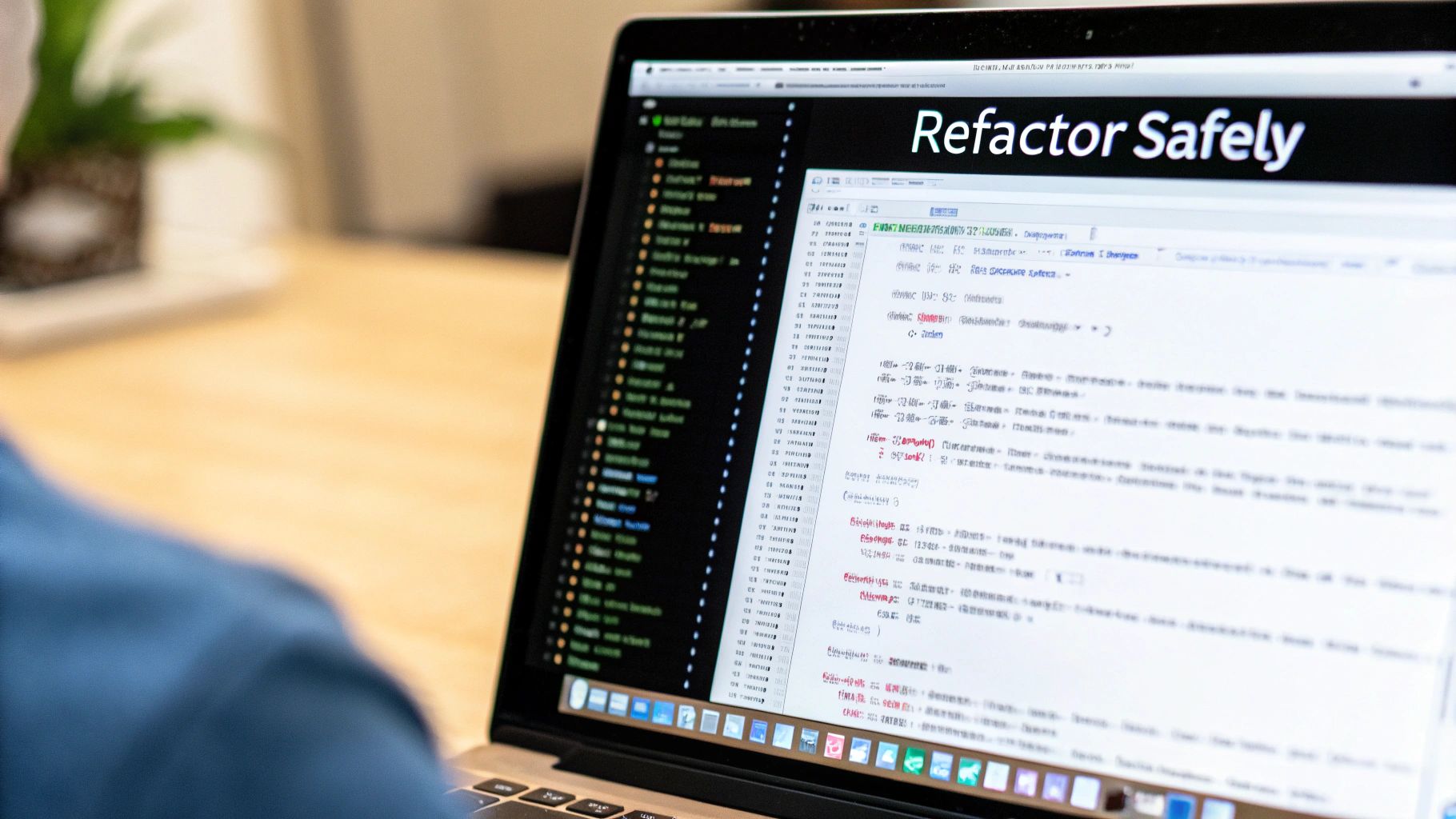refactor code meaning: What It Is and Why It Matters
refactor code meaning: Learn what it truly means, when to refactor, and how clean code boosts maintenance and team velocity.

Let's get straight to it. Code refactoring is the process of tidying up existing computer code—improving its internal structure and how easy it is to read—without actually changing what the software does. Think of it as a disciplined way to clean up code that already works, setting it up for a healthier future.
What Is Code Refactoring
Imagine your code is like a functional but messy workshop. You can build things, but finding the right tool is a struggle, and stray parts are scattered everywhere. You can still get the job done, but it's slow and frustrating.
Refactoring is like taking the time to organize that workshop. You aren’t building a new project; you're just putting tools on a pegboard, labeling drawers, and clearing the workbench. The next time you need to build something, the process will be smoother, faster, and far more pleasant.

That's exactly what code refactoring does. It doesn't add new features or fix obvious bugs. Instead, it strengthens the code's foundation, making it easier for any developer (including your future self) to understand, modify, and maintain.
The Fight Against Technical Debt
Every developer has been there: a tight deadline forces a shortcut. While it gets the feature out the door, this "quick and dirty" solution adds to what we call technical debt. It's the future cost of that shortcut—the extra time and effort it will take to fix or build upon that messy code later.
Over time, this debt piles up, making the entire system brittle and slow to change. Refactoring is how you pay down that debt.
As legendary software developer Martin Fowler puts it, refactoring is about making a series of small, safe changes that, on their own, might seem trivial.
Refactoring is a controlled technique for improving the design of an existing code base. Its essence is applying a series of small behavior-preserving transformations, each of which is "too small to be worth doing." However, the cumulative effect of these transformations is quite significant.
The key takeaway is that refactoring isn't some massive, one-off project. It’s a continuous habit of making tiny, incremental improvements that keep the codebase clean and manageable.
Refactoring Is Not Rewriting or Debugging
It's easy to confuse refactoring with other common coding tasks, but the distinction is critical. To make it crystal clear, let's compare what refactoring is versus what it is not.
Refactoring at a Glance
| Characteristic | What Refactoring Is | What Refactoring Is Not |
|---|---|---|
| Primary Goal | Improve internal code structure and readability. | Fix bugs or add new functionality. |
| External Behavior | Unchanged. The software does the exact same thing. | Changed. New features are added or bugs are removed. |
| Scope | Small, incremental, and safe changes. | A massive, risky overhaul of the entire codebase. |
| Analogy | Organizing the workshop. | Building a new piece of furniture. |
So, what does this all mean?
- It’s not debugging: While cleaning up code can sometimes expose hidden bugs, finding them isn't the main objective. The focus is purely on improving the code's design.
- It’s not adding new features: You should always refactor before you add new functionality. Clean the workspace first, then build on that solid, organized foundation.
- It’s not a complete rewrite: A rewrite involves throwing the old code away and starting from scratch. Refactoring is about carefully tweaking and improving the code you already have.
Ultimately, refactoring is proactive maintenance. It’s the essential practice that keeps your software healthy, adaptable, and ready for whatever comes next.
Why Refactoring Is an Essential Practice
"If it ain't broke, don't fix it." We've all heard that. So, why spend precious time rewriting code that technically works? This question comes up a lot, but it misses the point entirely. Refactoring isn't about fixing broken code; it's a strategic investment in making your software easier and faster to change in the future.
The biggest reason to refactor is to fight technical debt. Think of it as the unseen friction in your project. It’s the mess left behind by quick fixes and shortcuts. Every time a developer has to wade through confusing logic or untangle a web of dependencies, technical debt is slowing them down and making it more likely that new bugs will creep in.
Boosting Team Velocity and Collaboration
A clean, well-organized codebase is rocket fuel for a development team. When code is simple to read and understand, developers can add new features much more quickly and confidently. Bringing new people onto the team also becomes a breeze because they can get up to speed without needing their hand held for weeks.
Good code also makes for a happier, more collaborative team. It establishes a shared understanding of what "good" looks like, making code reviews more productive and cutting down on frustrating debates. When the code itself isn't the enemy, everyone can focus on building great things together.
The whole point of refactoring is to keep the code easy to understand and cheap to modify. It's a continuous practice, not a one-time cleanup, ensuring the long-term health and agility of your software.
This mindset of continuous improvement is absolutely vital. From a high-level perspective, knowing why refactoring is so important is a cornerstone of maintaining system health—a topic that frequently comes up in senior-level discussions like those covered in Technical Architect Interview Questions.
The Growing Importance of Clean Code
The challenge of keeping code clean has become so widespread that it's created a market of its own. In fact, the market for Codebase Refactoring AI tools hit USD 1.18 billion in a single year, all because companies are desperate to manage increasingly complex software.
This isn't just a niche trend; it shows a major industry shift towards prioritizing and even automating the process of maintaining code quality. You can find more details on this growing market over at Growth Market Reports.
The Real-World Payoffs of Refactoring
It’s one thing to know what refactoring is, but it’s another thing entirely to see what it can do for your project. When you make refactoring a regular practice, the benefits are very real and go way beyond just having "clean code." These advantages impact your team's speed, the quality of your product, and even their day-to-day happiness.

The first thing you'll notice is improved code readability. Think of clear, well-structured code as a great user manual for your software—it tells its own story. This clarity helps everyone on the team, from a brand-new hire to a seasoned veteran, get up to speed quickly and start contributing.
This leads directly to simplified maintenance. When the code makes sense, hunting down and squashing bugs becomes a much less painful (and risky) job. You can fix what's broken without worrying that you’re accidentally creating five new problems somewhere else.
Speed Up Development and Boost Team Morale
A clean codebase is a strong foundation for adding new things. It enables faster feature development because your team isn't fighting a tangled mess of code just to make a small change. Instead, they can build on a stable, predictable platform, which dramatically shortens the time it takes to bring new ideas to life. This is especially true when you need to modernize legacy applications, where years of clutter can bring progress to a halt.
While its main job isn't speed, refactoring often uncovers performance issues. The process forces you to take a hard look at old logic, and you’ll frequently find and fix inefficient code that was slowing the whole application down.
A project that embraces continuous refactoring will consistently outperform one drowning in technical debt. The difference is stark, showing up in faster development cycles, lower bug rates, and a more motivated and confident engineering team.
In the end, all these benefits feed into each other. A healthier codebase makes for happier, more productive developers. And happier developers build better, more reliable products. It’s a shift from constantly putting out fires to actually building something great.
Practical Refactoring Techniques You Can Use Today

Knowing the theory behind refactoring is great, but the real magic happens when you start applying it. The good news? You don't need to block off a week for a massive code cleanup.
Effective refactoring is all about making small, safe, and continuous improvements. Think of it less like a major renovation and more like tidying up a room as you go. Let’s look at a few simple but powerful techniques you can start using right away.
Extract Method
This is probably the most common—and most useful—refactoring technique in any developer's toolkit. Look for any chunk of code inside a larger function that seems to do one specific thing. You can pull that chunk out, give it its own descriptive name, and turn it into a new function.
This instantly makes the original code shorter and easier to follow, and you now have a new, reusable function.
Before: A long, confusing function function printOrderDetails(order) { // A bunch of code to calculate total let total = 0; for (const item of order.items) { total += item.price * item.quantity; }
// A bunch of code to print customer info
console.log(Customer: ${order.customer.name});
console.log(Address: ${order.customer.address});
console.log(Total Price: $${total});
}
After: A cleaner, modular approach function calculateTotal(order) { let total = 0; for (const item of order.items) { total += item.price * item.quantity; } return total; }
function printOrderDetails(order) {
const total = calculateTotal(order);
console.log(Customer: ${order.customer.name});
console.log(Address: ${order.customer.address});
console.log(Total Price: $${total});
}
See how much clearer that is? The printOrderDetails function now tells a simple story about what it does.
Rename Variable and Replace Magic Numbers
Good code should be easy to understand just by reading it. These two simple changes go a long way in making that happen.
- Rename Variable: Ditch those vague variable names like
dortemp. Change them to something that actually describes what they hold, likeelapsedDaysorcustomerName. It’s a tiny change with a huge impact on readability. - Replace Magic Number with Named Constant: A "magic number" is a random, unexplained value hard-coded into your logic. Seeing
if (status === 2)doesn't tell you much. But changing it toif (status === STATUS_APPROVED)makes the code's intention crystal clear without needing a comment.
The whole point of these small tweaks is to make your code tell a story. A new developer should be able to look at a function and get the gist of it without having to unravel a complex web of logic.
Getting comfortable with these techniques is a huge step. As you grow, you'll find that many common design patterns actually guide you toward a naturally refactored, cleaner structure.
Make these small cleanups a part of your daily routine and a topic of discussion during peer reviews. For more on that, check out our guide on code review best practices. By weaving these habits into your workflow, you’ll chip away at technical debt and keep your codebase a pleasant place to work.
Knowing When to Refactor Your Code
Understanding what refactoring is is one thing. Knowing when to do it is what really separates a good developer from a great one. Timing is everything. Jump the gun, and you might waste precious time. Wait too long, and you let technical debt pile up, making every future change a struggle.

A fantastic rule of thumb is the "Rule of Three." The first time you tackle a problem, you just get the code working. The second time you find yourself doing something very similar—maybe even copy-pasting—you should pause. But the third time you need that same logic, it's time to stop and refactor. Pull that code out into a proper reusable function or class.
Strategic Moments for Refactoring
Beyond general guidelines, certain moments in the development cycle are practically begging for a cleanup. Think of these as natural opportunities to strengthen your codebase before you move on.
- Before adding a new feature: If you're about to build something new, take a moment to clean up the code you'll be working with. It makes adding the new functionality so much easier and less risky.
- After fixing a bug: Chasing down a bug often shines a bright light on confusing or messy parts of the code. Once you've squashed it, refactor that area to make sure similar problems don't crop up again.
Your test suite is your ultimate safety net. With a solid set of automated tests, you can refactor aggressively and with confidence. You'll know instantly if a change accidentally breaks something.
Of course, sometimes you should absolutely not refactor. If a critical deadline is looming or the code is such a mess that a complete rewrite is the only sane option, then refactoring isn't the right move. Knowing when to hold back is just as important as knowing when to dive in.
The push for smarter development has led to a boom in AI-powered tools that can help with tasks like refactoring. The global market for these assistants was valued at USD 6.7 billion and is expected to climb to USD 25.7 billion by 2030. This shows a massive industry investment in making development faster and more efficient. Discover more insights about the AI code tool market.
Still Have Questions About Refactoring?
Even after getting the hang of what refactoring is, a few common questions tend to pop up. Let's walk through them to clear up any confusion.
Isn't Refactoring Just Rewriting Code?
Not at all. Think of it like this: refactoring is like renovating a house. You're improving the plumbing and electrical systems behind the walls (internal structure) without changing the room layout or its purpose (external behavior).
Rewriting, on the other hand, is like bulldozing the house and building a new one from the ground up. It’s a complete do-over, which is a much bigger, riskier, and more expensive project.
How Can I Justify This to My Boss?
It's all about framing it as an investment. Explain that taking a little time to refactor now saves a huge amount of time later. It's a direct attack on technical debt.
Cleaner code makes adding new features faster, significantly cuts down on bugs, and makes the entire system cheaper to maintain in the long run. It's a classic "pay a little now to save a lot later" scenario.
Does Refactoring Actually Fix Bugs?
While the main goal isn't to squash bugs, it happens all the time as a happy side effect. As you untangle complicated code and make things clearer, hidden flaws and logical errors often come to light.
Plus, once the code is clean, any new bugs that appear are way easier to spot and fix.
Can I Get Away with Refactoring Without Tests?
You could, but it’s incredibly risky. Your tests are your safety net. They're what tell you instantly if one of your "improvements" accidentally broke something.
Refactoring without a solid suite of automated tests is like walking a tightrope without a net—you might make it across, but one wrong move could be disastrous.
At 42 Coffee Cups, we specialize in transforming messy, complex code into clean, high-performing applications that are built to last. If you're buried in technical debt or need to bring your software up to modern standards, our expert teams can help you lay a solid foundation for growth. Learn how we help teams build better and faster.